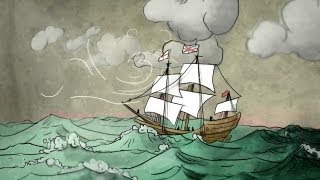(单词翻译:单击)
As you can imagine, 400 years ago, navigating the open ocean was difficult.
如同你想象的那样,400年前,在一望无际的大海上航行是件十分困难的事。
The winds and currents pushed and pulled ships off course,
风和海浪把船往前推、也会往后拉,
and so sailors based their directions on the port they left,
所以水手需要借由出航前的方向感,
attempting to maintain an accurate record of the ship's direction and the distance sailed.
尝试精准地记录船的方向和航行距离。
This process was known as dead reckoning,
这个过程被称做航位推算
because being just half a degree off could result in sailing right past the island that lay several miles just over the horizon.
因为半度的误差都会导致和小岛擦身而过,尽管这小岛就在地平线另一端而已。
This was an easy mistake to make. Thankfully, three inventions made modern navigation possible:
这是很容易犯的错误。所幸,有三样发明让现代航海变为可能:
sextants, clocks and the mathematics necessary to perform the required calculations quickly and easily.
六分仪、时钟、以及能提供快速简单算法的数学理论。
All are important. Without the right tools, many sailors would be reluctant to sail too far from the sight of land.
三者都很重要。没有正确的工具,水手们就会对太远的航行感到望而生畏。
John Bird, an instrument maker in London,
John Bird,一位伦敦的工具制造者,
made the first device that could measure the angle between the sun and the horizon during the day, called a sextant.
制造了第一个可以在白天测量太阳仰角的仪器,叫做六分仪。
Knowing this angle was important, because it could be compared to the angle back in England at the exact same time.
知道这个仰角很重要,可以将它与同时间在英国观察到的太阳仰角进行比较。
Comparing these two angles was necessary to determine the longitude of the ship. Clocks came next.
比较的结果对定位船只所在的经度有着至关重要的作用。接着时钟问世了。

In 1761, John Harrison, an English clockmaker and carpenter, built a clock that could keep accurate time at sea.
1761年时,John Harrison,一位英国的时钟制造者以及木匠,建造了一具在海上也能保持时间精准的时钟。
The timepiece that could maintain accurate time while on a pitching,
这个就算在船只左右颠簸的恶劣环境下,也能维持正确时间的定时器,
yawing deck in harsh conditions was necessary in order to know the time back in England.
对于知道何时返航回英国十分必要。
There was one catch though: since such a timepiece was handmade, it was very expensive.
但有一个隐忧:因为这样的定时器是手工制造的,所以非常昂贵。
So an alternate method using lunar measurements and intense calculations was often used to cut costs.
因此,为了节省开销,月象观测配合大量计算就成了常见的替代方案。
The calculations to determine a ship's location for each measurement could take hours.
利用计算来判断船所在的位置,要花上好几小时。
But sextants and clocks weren't useful unless sailors could use these tools to determine their position.
然而在水手们学会利用六分仪和时钟来判断方位之前,它们并没有太大用处。
Fortunately, in the 1600s, an amateur mathematician had invented the missing piece.
所幸,在十七世纪,一位业余数学家补足了那些缺陷。
John Napier toiled for more than 20 years in his castle in Scotland to develop logarithms, a calculation device.
John Napier在他位于苏格兰的城堡中钻研20余年,发展了“对数”这个计算工具。
Napier's ideas on logarithms involved the form of one over E and the constant 10 to the seventh power.
Napier关于对数的想法,涉及自然对数e的倒数和10的7次方这个常数。
Algebra in the early 1600s was not fully developed, and Napier's logarithm of one did not equal zero.
代数在十七世纪并还没有得到完全发展,而Napier的对数代入1时,并不等于0。
This made the calculations much less convenient than logarithms with a base of 10.
这使得它的计算,比起以10为底的对数麻烦许多。
Henry Briggs, a famous mathematician at Gresham College in London, read Napier's work in 1614,
Henry Briggs,一位伦敦格雷沙姆学院有名的数学家,读了Napier在1614年的著作后,
and the following year made the long journey to Edinburgh to meet Napier.
来年就不远千里地到爱丁堡拜访Napier。
Briggs showed up unannounced at Napier's castle door
Briggs毫无征兆地出现在Napier的城堡门口,
and suggested that John switch the base and form of his logarithms into something much simpler.
然后建议他将原本的底数换成较简单的数字。
They both agreed that a base of 10 with the log of one equal to zero would greatly simplify everyday calculations.
他们一致认为以10为底、并将log(1)设为0会大大简化日常所需的计算。
Today we remember these as Briggs Common Logarithms.
这就是我们今日所熟知的Briggs常用对数。
Until the development of electric calculating machines in the 20th century,
一直到二十世纪发展出电子计算器之前,
any calculations involving multiplication, division, powers, and extraction of roots with large and small numbers were done using logarithms.
所有涉及大小数字的乘法、除法、指数以及根号这些运算,都离不开对数。
The history of logarithms isn't just a lesson in math.
对数的历史并不只是一堂数学课。
There were many players responsible for successful navigation.
有许多人对成功的航海技术做出了贡献。
Instrument makers, astronomers, mathematicians, and of course sailors.
工具制造者、天文学家、数学家,当然,还有水手们。
Creativity isn't only about going deep into one's field of work, it's about cross-pollination between disciplines too.
创造力并不只是在自己的领域内不断深入,也应该是不同领域之间的相辅相成。


